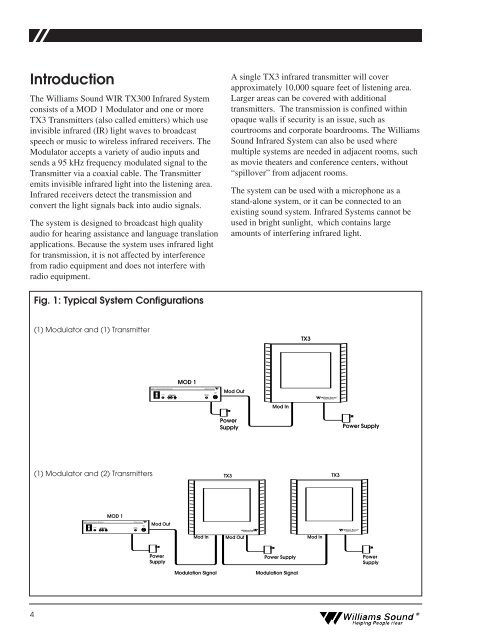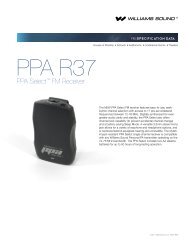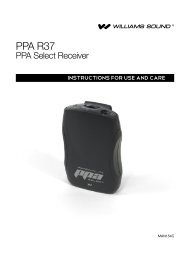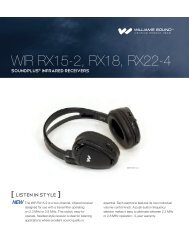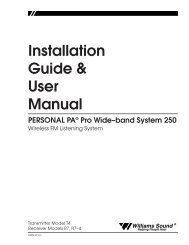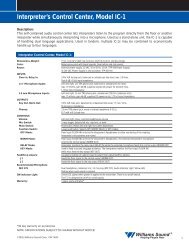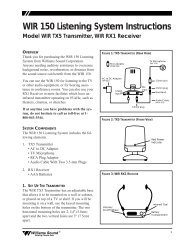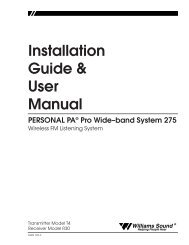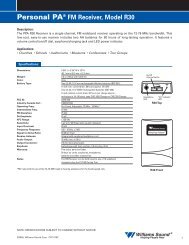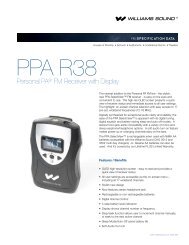Installation Guide & User Manual - Williams Sound
Installation Guide & User Manual - Williams Sound
Installation Guide & User Manual - Williams Sound
You also want an ePaper? Increase the reach of your titles
YUMPU automatically turns print PDFs into web optimized ePapers that Google loves.
MOD 1 Infrared System Modulator<br />
I<br />
0<br />
Power<br />
Ok<br />
Audio Level<br />
Hi<br />
- +<br />
Adjust<br />
<strong>Williams</strong> <strong>Sound</strong><br />
Infrared<br />
Test Out<br />
Tape<br />
Out<br />
I<br />
0<br />
Power<br />
Ok<br />
Audio Level<br />
Hi<br />
- +<br />
Adjust<br />
Introduction<br />
The <strong>Williams</strong> <strong>Sound</strong> WIR TX300 Infrared System<br />
consists of a MOD 1 Modulator and one or more<br />
TX3 Transmitters (also called emitters) which use<br />
invisible infrared (IR) light waves to broadcast<br />
speech or music to wireless infrared receivers. The<br />
Modulator accepts a variety of audio inputs and<br />
sends a 95 kHz frequency modulated signal to the<br />
Transmitter via a coaxial cable. The Transmitter<br />
emits invisible infrared light into the listening area.<br />
Infrared receivers detect the transmission and<br />
convert the light signals back into audio signals.<br />
The system is designed to broadcast high quality<br />
audio for hearing assistance and language translation<br />
applications. Because the system uses infrared light<br />
for transmission, it is not affected by interference<br />
from radio equipment and does not interfere with<br />
radio equipment.<br />
A single TX3 infrared transmitter will cover<br />
approximately 10,000 square feet of listening area.<br />
Larger areas can be covered with additional<br />
transmitters. The transmission is confined within<br />
opaque walls if security is an issue, such as<br />
courtrooms and corporate boardrooms. The <strong>Williams</strong><br />
<strong>Sound</strong> Infrared System can also be used where<br />
multiple systems are needed in adjacent rooms, such<br />
as movie theaters and conference centers, without<br />
“spillover” from adjacent rooms.<br />
The system can be used with a microphone as a<br />
stand-alone system, or it can be connected to an<br />
existing sound system. Infrared Systems cannot be<br />
used in bright sunlight, which contains large<br />
amounts of interfering infrared light.<br />
Fig. 1: Typical System Configurations<br />
(1) Modulator and (1) Transmitter<br />
TX3<br />
MOD 1<br />
MOD 1 Infrared System Modulator<br />
<strong>Williams</strong> <strong>Sound</strong><br />
Infrared<br />
Test Out<br />
Tape<br />
Out<br />
Mod Out<br />
<strong>Williams</strong> <strong>Sound</strong> ®<br />
Helping People Hear<br />
Mod In<br />
Power<br />
Supply<br />
Power Supply<br />
(1) Modulator and (2) Transmitters<br />
TX3<br />
TX3<br />
MOD 1<br />
Mod Out<br />
<strong>Williams</strong> <strong>Sound</strong> ®<br />
Helping People Hear<br />
<strong>Williams</strong> <strong>Sound</strong> ®<br />
Helping People Hear<br />
Mod In Mod Out Mod In<br />
Power<br />
Supply<br />
Power Supply<br />
Power<br />
Supply<br />
Modulation Signal<br />
Modulation Signal<br />
4<br />
<strong>Williams</strong> <strong>Sound</strong> ®<br />
Helping People Hear


